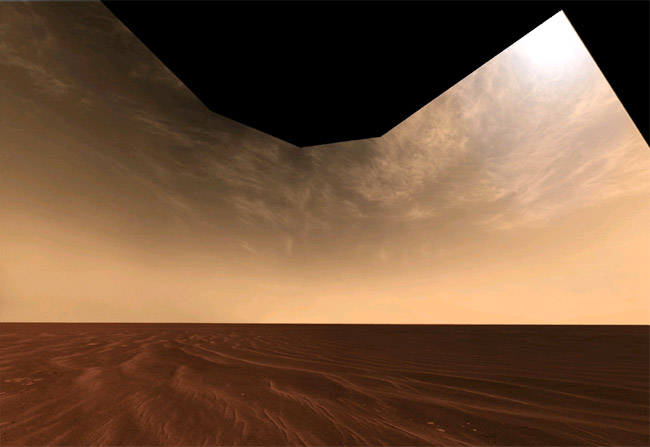Night Clouds Warm Red Planet

Nighttimeclouds detected for the first time on Mars help to keep the planet's surfacewarm after sunset when temperatures drop, a new study suggests.
Thenocturnal clouds are five times thicker than their daytime counterparts and hoverclose to the ground, almost like a fog.
The study,conducted by researchers at NASA and the National Oceanic and AtmosphericAdministration (NOAA), is detailed in the Feb. 1 issue of GeophysicalResearch Letters.
Clandestineclouds
Martianclouds-both the day and night variety--resemble the wispy and high-flying cirrus cloudson Earth, except they are thicker andfound at more variable heights. Previous studies have detected daytime cloudson Mars as high as 62 miles (100 km)above the surface, making them the highestflying clouds ever detected on any planet.
Nighttimeclouds are harder to spot. During the day, Martian clouds appear brighter thanthe planet's surface because they reflect more sunlight. Daytime clouds [image]also stand out in thermal imaging because they are much cooler than the Martiansurface.
At night,these differences disappear. There is no longer any sunlight to reflect, andsurface temperatures drop until there is hardly any temperature contrast leftbetween Martian cloud and surface.
Breaking space news, the latest updates on rocket launches, skywatching events and more!
Atemperature anomaly
Nighttimeclouds [image]on Mars are predicted from computer models, but none had been directly observeduntil now. The researchers discovered the stealthy clouds after investigating atemperature anomaly that occurs on the Martian surface at night picked up bythe now-lostMars Global Surveyor(MGS).
"We foundthat in certain regions the temperature didn't drop as much as we would'veexpected it to drop," said study leader John Wilson of NOAA.
Using the MGS'slaser altimeter, the researchers created the first map of Martian clouds atnight. An altimeter works by bouncing a pulse of light off the planet'ssurface. Depending on how the pulse behaves--whether it is absorbed, reflectedor scattered--scientists can distinguish between cloudsfloating in the atmosphere and rockson the planet surface.
The measurementsshowed that the parts of the planet's surface blanketed by clouds at night werewarmer by about 35 degrees Fahrenheit than those that were exposed andunprotected by clouds.
This sameeffect occurs on Earth. "A cloudy night won't be as cold as a clear night," Wilson told SPACE.com. "If thereare no clouds, the radiation from the surface just goes straight off into spacerather than being bounced back."
In Mars'distant past, when the planet was much warmer and wetter than it is now, cloudswould have been more abundant and contributed to its greenhouse effect, theresearchers speculate.
"The waterice clouds would be very prominent," Wilson said, "and may have had a very important role in affecting Mars'climate, maybe helping to make the planet warmer."
- Gallery: Visualizations of Mars
- Image Gallery: Curious Clouds
- Mars Clouds Higher Than Any On Earth
- The Definition of 'Cloud' Gets Cloudy
Ker Than is a science writer and children's book author who joined Space.com as a Staff Writer from 2005 to 2007. Ker covered astronomy and human spaceflight while at Space.com, including space shuttle launches, and has authored three science books for kids about earthquakes, stars and black holes. Ker's work has also appeared in National Geographic, Nature News, New Scientist and Sky & Telescope, among others. He earned a bachelor's degree in biology from UC Irvine and a master's degree in science journalism from New York University. Ker is currently the Director of Science Communications at Stanford University.
